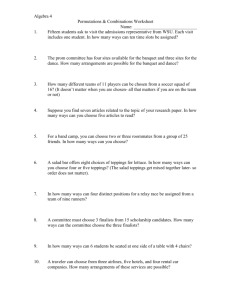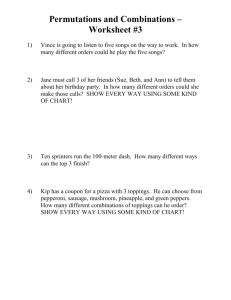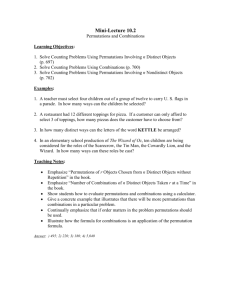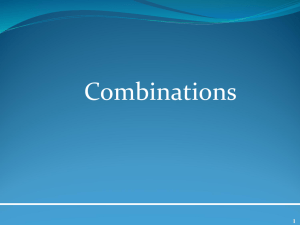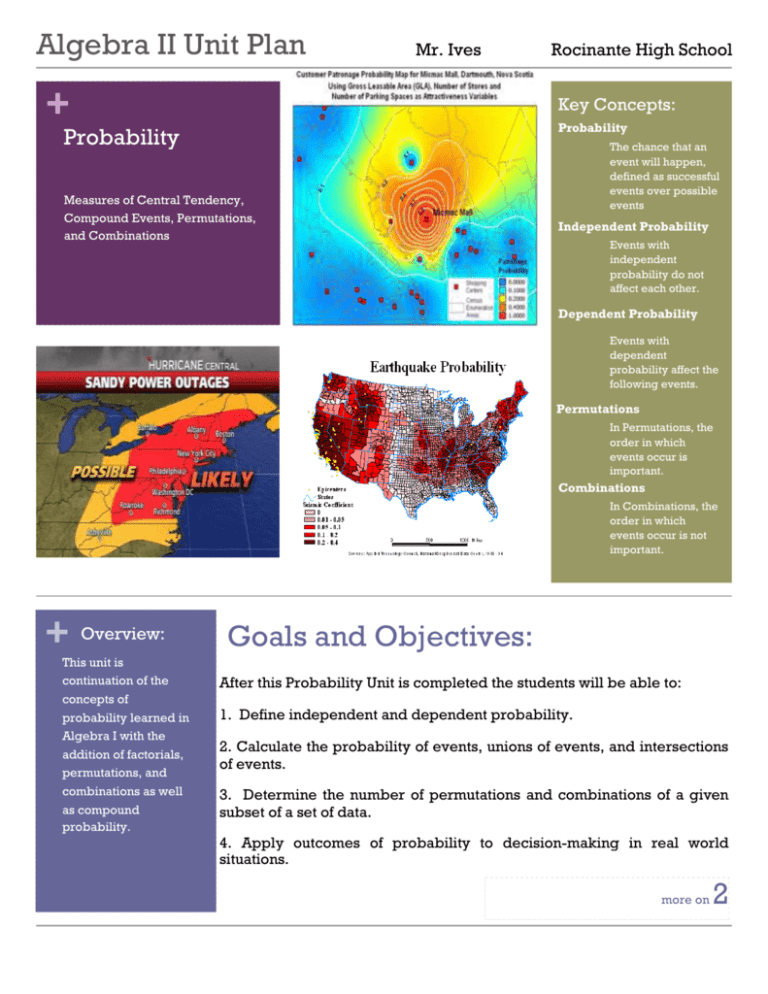
Algebra II Unit Plan
Mr. Ives
+
Rocinante High School
Key Concepts:
Probability
Probability
Measures of Central Tendency,
Compound Events, Permutations,
and Combinations
The chance that an
event will happen,
defined as successful
events over possible
events
Independent Probability
Events with
independent
probability do not
affect each other.
Dependent Probability
Events with
dependent
probability affect the
following events.
Permutations
In Permutations, the
order in which
events occur is
important.
Combinations
In Combinations, the
order in which
events occur is not
important.
+ Overview:
This unit is
continuation of the
concepts of
probability learned in
Algebra I with the
addition of factorials,
permutations, and
combinations as well
as compound
probability.
Goals and Objectives:
After this Probability Unit is completed the students will be able to:
1. Define independent and dependent probability.
2. Calculate the probability of events, unions of events, and intersections
of events.
3. Determine the number of permutations and combinations of a given
subset of a set of data.
4. Apply outcomes of probability to decision-making in real world
situations.
more on
2
Probability and Statistics Unit
Mr. Ives
Mnemonic:
Probability Equals
Success Over Possible!"
The probability of an
event is the number of
ways an event can
occur successfully
divided by the total
possible outcomes.
Common Core Standards Addressed:
Statistics and Probability: Summarize, represent, and interpret data on a single
count or measurement variable.
CCSS.Math.Content.HSS-ID.A.1
Represent data with plots on
the real number line (dot plots,
histograms, and box plots).
CCSS.Math.Content.HSS-CP.A.2
Understand that two events A
and B are independent if the
probability of A and B
occurring together is the
product of their probabilities,
and use this characterization to
determine if they are
independent.
CCSS.Math.Content.HSS-ID.A.3
Interpret differences in shape, center,
and spread in the context of the data
sets, accounting for possible effects of
extreme data points (outliers).
CCSS.Math.Content.HSS-CP.A.3
Understand the conditional probability
of A given B as P(A and B)/P(B), and
interpret independence of A and B as
saying that the conditional probability
of A given B is the same as the
probability of A, and the conditional
probability of B given A is the same as
the probability of B.
CCSS.Math.Content.HSS-IC.B.6
Evaluate reports based on data.
CCSS.Math.Content.HSS-CP.B.9
Use permutations and
combinations to compute
probabilities of compound events
and solve problems.
Importance:
Probability is the single most important concept in modern mathematics. Computers
have made the gathering of statistics and data incredibly easy, but there still remains
the task of analyzing meaningful trends and creating predictions from the data. In my
own careers, I have used probability to control production and waste in my
restaurants, and to assess weather trends for flight plans.
Students must understand that the power of prediction by probability, especially in a
world with billions of human beings, is not only critical to their own personal future,
but to the future of their entire generation.
Rocinante High School
2
Probability and Statistics Unit
+
Mr. Ives
Lesson Plan Overview
Two Week Timeline
Week 1 Day 1: Introduction to Probability
Focus Activity: Name one thing you know about probability.
The students will write the focus activity in their data folder on the top of the page of Cornell Notes they will take for the
day. At the bottom of the notes will be the reflection on learning.
Teaching Strategies and Activities:
Slideshow: Probability and its applications for use in the real world including earthquake prediction, business
mapping, traffic mapping, and weather prediction.
Essential Questions:
"What are Measures of Central Tendency?"
"Why is it necessary to find a Central Tendency in data?"
"What is an outlier and what effects does an outlier have on the decisions we should make in describing the data?"
"Predict the kinds of jobs you think would need people with this skill."
Presentation: Measures of Central Tendency: Mean, Median, Mode, Range, and Outliers.
Cornell Notes: Use graphs of each possible distribution of data to show the correct uses of each
Rocinante High School
(continued)
3
Probability and Statistics Unit
measure of central tendency. Then the teacher will have the students generate
the rule that is used for deciding the correct measure of central tendency to use
on a given set of data.
Agile Mind: Revisiting Probability: Overview: The software has an excellent
story on the arrest and investigation of a robbery and trial using probability of
circumstantial evidence as a defense for the accused .and the orientation part of
this will be used as a preview of the skills.
Guided and Independent Practice: The students will definitely need to
remediate the many skills included in this lesson. Other resources included will
be practice problems in the basic skill.
Reflection on Learning: The students reflect in a one or two sentence paragraph
on what, if anything, they learned today. They may reflect on any learning, even
learning of behavior, real world applications, just the basic facts of the lesson, or
Mr. Ives
+
Unit Vocabulary:
Events
Certain Events
Impossible events
Union of Events
Intersection of Events
Addition Rule
Special Case of the
Addition Rule
even a personal reflection of their own journey.
Mutually Exclusive
Events
Best Practices: I like to use a group in a club that has an obvious outlier of one
Disjoint events
age that is significantly larger than all the others. The students can see that the
Mean is no longer a good measure of central tendency, and can see that the
Median will give a closer approximation.
Complementary
Events
Factorial
Week 1 Day 2:
Measures of Central Tendency Applications
The Fundamental
Counting Principle
Focus Activity: Name one thing you know about gambling!
Permutations
The students will write the focus activity in their data folder on the top of the page
of Cornell Notes they will take for the day. At the bottom of the notes will be the
Combinations
reflection on learning. The focus activities at the beginning of the week lead up to
the Probability Simulation on Wednesday.
Teaching Strategies and Activities:
Practice and Vocabulary Activity: Probability Concentration: Students pick
pairs of hidden cards for a match. When a match is found the student must
correctly name the given probability or correct definition to get a point. If
successful, the student gets to pick again. Turns rotate after a student misses.
(continued)
Rocinante High School
4
Probability and Statistics Unit
"Probability
is only the
chance an
event may
happen!"
Mr. Ives
Dependent and Independent Practice - Applications: The students will work
constructed response problems today emphasizing real-world situations and making
inferences and decisions based on the data. The most important concept of the day is
the effect that an outlier has on the mean of a set of data, and the correct parameters for
choosing a measure of central tendency for a set of data.
Here's an example of a problem that calls for the students to analyze the results of an
outlier and to make predictions and inferences from the given data:
Week 1 Day 3
Probability Simulation!
Focus Activity: Name one thing you know about casinos!
The students will write the focus activity in their data folder on the top of the page of Cornell Notes they will take for
the day. At the bottom of the notes will be the reflection on learning. The focus activity for today will be linked to an
examination of the probability settings of slot machines and casino games.
Teaching Strategies and Activities:
Probability Simulation:
Today I will run a real world simulation of probability! I begin by having a small group discussion of probability as it
involves weather forecasting. I ask questions like, "Have you ever seen a weather forecast that stated the chance of
rain was 80% or higher, yet when you looked out a window it was sunny? Or have you ever seen a day forecast to be
sunny already overcast and raining? Why did that happen?" After letting the students predict, I explain that
probability is just the chance that something might happen. In the weather example, 80 days out of 100 when the
conditions were the same as that day, it rained. But on 20 days...it didn't!
Then I hand out manipulatives in the form of one six-sided die per student. I tell them that I will predict the future
with probability. Then I ask them to choose one number that we will all try to roll on the dice. We calculate the
probability of that number which is always 0.16 repeating for any number on the die, and then I multiply that
probability by the number of students in the room.
Rocinante High School
(continued)
5
Probability and Statistics Unit
Mr. Ives
That will give a number of around 3 to 4 for an average sized classroom. After I have made the prediction, the entire
class rolls the dice four or five times, and we record the number of correct rolls. When the average is computed it will
usually be within a few hundredths of the prediction. Many times, some of the rolls will vary widely, but other rolls
will cancel them out in the opposite direction.
I then have the small groups of students discuss what would happen if we had roll the dice more times, lots more
times, or less times. This brings them to the concept that probability is inaccurate with small sets of data, but
extremely precise with large sets. Leading questions include:
"In what situations would it be good to know the future?"
"How could you use probability in your own business plan?"
"How would a city and its planners use probability?"
Essential Questions:
"What are Measures of Central Tendency?"
"Why is it necessary to find a Central Tendency in data?"
"What is an outlier and what effects does an outlier have on the
decisions we should make in describing the data?"
"Predict the kinds of jobs you think would need people with this
skill."
Cornell Notes: Definitions of Independent Probability and Dependent Probability will be included, as well as
examples of both.
Agile Mind: Events: And, Or, and Not: Conditional probability will fit right in with dependent probability at this
point. I have the student do the reading of the paragraphs for technical reading practice. It is important to have
reading rules previously set up for behavior:
1. Only the teacher will correct readers.
2. No one should be talking, respect the reader.
Guided and Independent Practice: A little independent practice is always good idea. The students usually pick
these concepts quickly and easily so time is not an issue. Other resources included will be practice problems in the
basic skill.
Reflection on Learning: The students reflect in a one or two sentence paragraph on what, if anything, they learned
today. They may reflect on any learning, even learning of behavior, real world applications, just the basic facts of the
lesson, or even a personal reflection of their own journey.
Best Practices: This is a great time to have a class discussion of casinos, gambling, and dependent probability of
games like poker. I throw in a mini-lesson of the probability of winning the lottery and we all discuss how buying
more tickets may technically increase your probability, but it is still so small as to be statistically insignificant.
Rocinante High School
(continued)
6
Probability and Statistics Unit
Resources/Materials:
Agile Mind Software and Resources
Technology / Science / Mathematics Slideshows
Education YouTube videos
Mr. Ives
Probability can
predict weather
disasters like
earthquakes,
tsunamis, hurricanes,
and tornados!
Glencoe Algebra II textbook and resources
Manipulatives and Puzzles
Laptop Computers
Pencil and Paper
Data Folder and Formula Sheet
Probability Manipulatives: Dice, Spinners, etc.
Week 1 Day 4
Permutations and Multiplication Counting Principle Pt. I
Focus Activity:
Differentiated Learning: Visual / Spatial: A fun activity to try is to have each student write their name on their
paper. Then try to write every possible combination of the letters of their name in order. The students will quickly
realize that a formula is needed!
Teaching Strategies: Prerequisite Skills: Factorials.
The ability to compute and simplify factorials is a necessary skill to be able to use the Permutation formula:
Essential Questions:
"What is the Multiplication Counting Principle and how does it relate to Sample Spaces?"
"What is a Factorial?"
"How are Factorials used to calculate possibilities?"
"Can Factorials be simplified?"
Rocinante High School
(continued)
7
Probability and Statistics Unit
Probability can
be used to
predict fire
danger!
Mr. Ives
Agile Mind: Exploring "And, Or, and Not" Compound Probability:
The Agile Mind software has a good example of the uses of permutations and
examples of compound probability involving a case of murder, Rob Berry, and his
lawyer Dewey Cheatem, who defends Rob from the Arresta Police. I use this section
to introduce compound probability.
Multiplication Counting Property Activity: Make the Grossest Sandwich!
It's time now, before transitioning to factorials, to introduce the Multiplication
Counting Property. Ask the students to work together in groups to think of the
grossest sandwich possible using any combination of 2 meats, 3 vegetables, and 2
spreads. After they have done this, ask random groups for their grossest meats,
vegetables, and spreads. Have the class create a consensus. Then ask, "How many
possible sandwiches can we make from these ingredients?" After getting a
prediction, make a tree graphic organizer to assemble the ingredients. The
branching tree clearly shows the process of the M.C.P. Ask "Did the prediction
equate to the result?" If it did, and it sometimes will, now is the time to ask, "Is there
a faster way to use these numbers to come up with a solution?" Students will usually
instantly see the connection between the possibilities and the results is linked by
multiplication. For fun, and time permitting, repeat the experiment using weird
clothing ensembles.
Presentation: Factorials and Simplifying Factorials:
Students usually have not worked with factorials at this point in their education, so it's
important to have them find the factorial key on their calculator, use it a couple of
times, and find out for themselves that factorials get big very quickly. After that,
show them the basics of simplifying factorials using cancelation.
Guided / Independent Practice:
A practice session should follow next since this is a new skill.
Cornell Notes: An example of a factorial should go on the left column, for example:
4! = 4*3*2*1 = 24 . The formula for Permutations should also be placed there.
Reflection on Learning: The students reflect in a one or two sentence paragraph on
what, if anything, they learned today. They may reflect on any learning, even
learning of behavior, real world applications, just the basic facts of the lesson, or
even a personal reflection of their own journey.
insignificant.
Rocinante High School
(continued)
8
Probability and Statistics Unit
Best Practices:
It's important to give the students time to simplify factorials for themselves. It won't take
too long, students usually pick up the skill right away.
Week 1 Day 5:
Mr. Ives
Probability is
used to
determine the
effectiveness of
new medicines!
Geometric Probability Kinesthetic Activity: Nets!
At the end of a week filled with new concepts, it's good to take a break and do some
kinesthetic activity. For this unit, the students will get a quick lesson on geometric
probability, then they will cut out two-dimensional nets of three-dimensional
polyhedrons, color them and compute the geometric probability of the colored part.
Best practice:
The students will be tempted to make their job easy by completely coloring one side
and not coloring other sides at all, so to head this off and give the student some freedom
of expression. Make sure to tell them that only one side needs to be used for the
calculation (and 100% probability is not allowed!) and that they may feel free to
decorate the other sides as they wish. It's also fun to do this activity near a holiday so
that the students may make it holiday-themed.
Week 2 Day 1:
Permutations Pt. II
Now that the students have the necessary prerequisite skills, it's time to work with the
permutation formula.
Focus Activity: Write one thing you know about baseball! Since batting order is
important in baseball, that is a perfect example of when permutations come into play.
Finding the permutations of possible batting orders is a fun way to introduce
permutations.
Teaching Strategies and Activities:
Video: "The Permutation Song" by Michael Steiner. What a fun way to learn...by
singing! Available from YouTube Education.
Essential Questions:
Rocinante
High School
"What are Measures of Central Tendency?"
"Why is it necessary to find a Central Tendency in data?"
9
Probability and Statistics Unit
Mr. Ives
Guided Independent Practice:
The students will now solve permutation problems.
They have the necessary skills to run the formula. the
guided practice will consist of two or three algorithmic
problems and one constructed response problem with
input from the small groups. The independent
practice will consist of seven algorithmic problems
and four more constructed response problems.
Assessment: Formative:
I usually work through the class one-on-one and see if I
can head off problems involving simplification of factorials. I also look for difficulty in reading, understanding, and
setting up the constructed response questions. I have a mnemonic device for setting up constructed response
problems:
A.
Analyze. What kind of problem is it? Do you have a formula? What do you know about these problems?
D.
Draw a Picture. Try to draw a picture, a graph, a table, or a graphic organizer of this problem.
D.
Design the Problem. Set the problem up or fill in the formula.
S.
Solve. Solve the problem or evaluate the formula.
Rats! Every permutation in
the universe IS possible!
Assessment: Summative
The students will evaluate their work on the basis of the rubric in
their data folders.
Reflection on Learning: The students reflect in a one or two
sentence paragraph on what, if anything, they learned today.
They may reflect on any learning, even learning of behavior, real
world applications, just the basic facts of the lesson, or even a
personal reflection of their own journey.
Week 2 Day 2:
Combinations:
Things can speed up quite nicely now that the students not only have experience with Factorials, but also with
Permutations since the Combinations formula is very similar to the Permutations formula.
Focus Activity:
Name all the possible combinations of people that two people in your group could present today! Since the order is
no longer important in Combinations, this is a good way to both get a warm up activity and set up for student
presentations.
Rocinante High School
10
Probability and Statistics Unit
Mr. Ives
Modifications:
Teaching Strategies:
I will present the formula for Combinations which is similar to the
Permutation Formula but in Combinations, order does not matter. Ask
the students, "In what situations in real life would order of picking not
matter?" Good answers will include pizza toppings, poker hands, and
Extended time for completion of
assignments or tests.
Additional time for reading
assignments.
randomly choosing people to represent groups. Bad answers include
places in an Olympic event, or letters in a word. (You can insert a fun
mini-lesson on the fact that choosing the order of pizza toppings might
be important for flavor and cooking.) Make sure to introduce the
Combinations of Multiple Events at the end of the presentation of
Combinations.
Guided / Independent Practice:
The students will now solve Combination problems working
cooperatively in small groups. They have the necessary skills to run
the formula. Guided practice will consist of two or three algorithmic
Time for repeated drill and review.
small groups.
Data folders with study sheets,
vocabulary sheets, and other
supplemental aids.
Visual demonstrations which include
the presentation of material in small
steps.
Multisensory materials and activities
(written, spoken, demonstration,
kinesthetic.)
problems and one constructed response problem with input from the
small groups. Independent practice will consist of seven algorithmic
Mnemonic devices and aids.
problems and four more constructed response problems. At the end of
Word processor with spell checker
and calculator.
the hour, a random group will be chosen and the students chosen in the
focus activity by their small group will present one or two of the
constructed response problems to the class.
Best Practice - Flexibility
It is good to give the students a set of problems where they have to
determine whether or not order is important and apply the correct
Permutation or Combination formula to them.
Reflection on Learning: The students reflect in a one or two sentence
paragraph on what they learned today.
Week 2 Day 3
Assisted note-taking and note-taking
guidelines.
Credit for participation, effort and
attendance as well as completed
work.
One-to-one teacher contact daily.
Assistance with organization and
planning as well as organized
classroom procedures and materials.
Peer / pair tutoring and cooperative
learning.
Emphasis on success.
Formal Summative Assessment:
A twenty question test covering the entire unit with at least two
Seating to reduce distractions.
vocabulary questions and two constructed response questions.
Clearly defined limits and classroom
procedures.
My thanks to Michael Steiner for the "Permutation Song."
Cooling off periods and concrete,
positive re-enforcement.
© 2013 Jonathan Ives
All Rights Reserved
Rocinante High School
11

